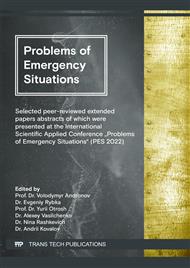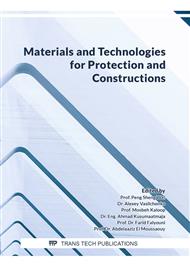[1]
Yu. Tsapko, O. Horbachova, А. Tsapko, S. Mazurchuk, D. Zavialov, N. Buiskykh, Establishing regularities in the propagation of phase transformation front during timber thermal modification. Eastern-European Journal of Enterprise Technologies, 1/10 (109) (2021) 30-36.
DOI: 10.15587/1729-4061.2021.225310
Google Scholar
[2]
Yu. Tsapko, I. Rogovskii, L. Titova, T. Bilko, А. Tsapko, O. Bondarenko, S. Mazurchuk, Establishing regularities in the insulating capacity of a foaming agent for localizing flammable liquids. Eastern-European Journal of Enterprise Technologies, 5/10 (107) (2020) 51-57.
DOI: 10.15587/1729-4061.2020.215130
Google Scholar
[3]
O.Yu. Berdnyk, O.V. Lastivka, A.A. Maystrenko, N.O. Amelina, Processes of structure formation and neoformation of basalt fiber in an alkaline environment. IOP Conference Series: Materials Science and Engineering, 907 (2020) 012036.
DOI: 10.1088/1757-899x/907/1/012036
Google Scholar
[4]
G. Vladimir, L. Oles, B. Oksana, T. Oleksandr, S. Petro, Corrosion resistance of polyester powder coatings using fillers of various chemical nature. Key Engineering Materials, 864 (2020) 115-121.
DOI: 10.4028/www.scientific.net/kem.864.115
Google Scholar
[5]
M. Petrič, B. Knehtl, A. Krause, C. Welzbacher, P. Gérardin, Wettability of waterborne coatings on chemically and thermally modified pine wood. Journal of Coatings Technology and Research, 4 (2) (2007) 203-206.
DOI: 10.1007/s11998-007-9023-2
Google Scholar
[6]
Yu. Tsapko, A. Tsapko, O. Bondarenkо, Research of conditions of removal of fire protection from building construction. Key Engineering Materials, 864 (2020) 141-148.
DOI: 10.4028/www.scientific.net/kem.864.141
Google Scholar
[7]
Yu. Tsapko, A. Tsapko, O. Bondarenkо, Modeling of thermal conductivity of reed products. IOP Conf. Series: Materials Science and Engineering. Innovative Technology in Architecture and Design, 907 (2020) 012057.
DOI: 10.1088/1757-899x/907/1/012057
Google Scholar
[8]
A. Kutnar, Kričej B., M. Pavlič, M. Petrič, Influence of treatment temperature on wettability of Norway spruce thermally modified invacuum. Journal of Adhesion Science and Technology, 27 (9) (2013) 963-972.
DOI: 10.1080/01694243.2012.727168
Google Scholar
[9]
W. Wang, Y. Zhu, J. Cao, W. Sun, Correlation between dynamic wetting behaviour and chemical components of thermally modified wood. Applied Surface Science, 324 (2015) 332-338.
DOI: 10.1016/j.apsusc.2014.10.139
Google Scholar
[10]
R. Herrera, M. Muszyńska, T. Krystofiak, J. Labidi, Comparative evaluation of different thermally modified wood samples finishing with UV-curable and waterborne coatings. Applied Surface Science, 357 (2015) 1444-1453.
DOI: 10.1016/j.apsusc.2015.09.259
Google Scholar
[11]
R. Herrera, J. Sandak, E. Robles, T. Krystofiak, J. Labidi, Weathering resistance of thermally modified wood finished with coatings of diverse formulations. Progress in Organic Coatings, 119 (2018) 145-154.
DOI: 10.1016/j.porgcoat.2018.02.015
Google Scholar
[12]
R. Benkreif, F.Z. Brahmia, C. Csiha, Influence of moisture content on the contact angle and surface tension measured on birchwood surfaces. European Journal of Wood and Wood Products, 79 (4) (2021) 907-913.
DOI: 10.1007/s00107-021-01666-6
Google Scholar
[13]
M.H. Ramage, H. Burridge, M. Busse-Wicher, G. Fereday, T. Reynolds, S.U. Darshil, G. Wu, L. Yu, P. Fleming, D. Densley-Tingley, The wood from the trees: The use of timber in construction. Renew. Sustain. Energy Rev, 68 (2017) 333-359.
DOI: 10.1016/j.rser.2016.09.107
Google Scholar
[14]
K.E. Larsen, N. Marstein, Conservation of Historic Timber Structures: An Ecological Approach. Butterworth-Heinemann Series in Conservation and Museology, (2016) 333-359.
Google Scholar
[15]
E. Rekiel, A. Zdziennicka, B. Jańczuk, Mutual influence of ethanol and surfactin on the ir wetting and adhesion properties. Colloids and Surfaces A: Physicochemical and Engineering Aspects, 627 (2021) 127161.
DOI: 10.1016/j.colsurfa.2021.127161
Google Scholar
[16]
J. Traciak, J. Fal, G. Żyła, 3D printed measuring device for the determination the surface tension of nanofluids. Applied Surface Science, 561 (2021) 149878.
DOI: 10.1016/j.apsusc.2021.149878
Google Scholar



